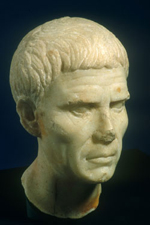
Minturnae lies 65 kilometers northwest of Naples, where the Via Appia crosses the Garigliano (ancient Liris) River on the border between Latium and Campania. Originally inhabited by Italic tribesmen called the Aurunci, Minturane was conquered by the Romans in 313 B.C. The site soon grew to a respectable size, in part because the Via Appia ran directly alongside it, but it was badly damaged by fires toward the end of the Republic. Recolonized by Augustus, Minturnae enjoyed a long existence until its final abandonment about A.D. 590. The site was excavated under the auspices of the University Museum by Jothan Johnson between 1931 and 1933, and the Museum received part of the discoveries by agreement with the Italian Department of Antiquities. Architectural terracottas make up the Museum's most exceptional finds from Minturnae. Although typical of central and northern Italo-Etruscan buildings, such decorations are rarely found in museums outside of Italy. The once colorfully painted revetments are part of a native Italic crafts tradition. Conservative traditionalists like Cato the Elder (243-149 B.C.) praised the technique, but such terracottas eventually lost their appeal and disappeared. Minturnae marks the furthest south that they have been found.
